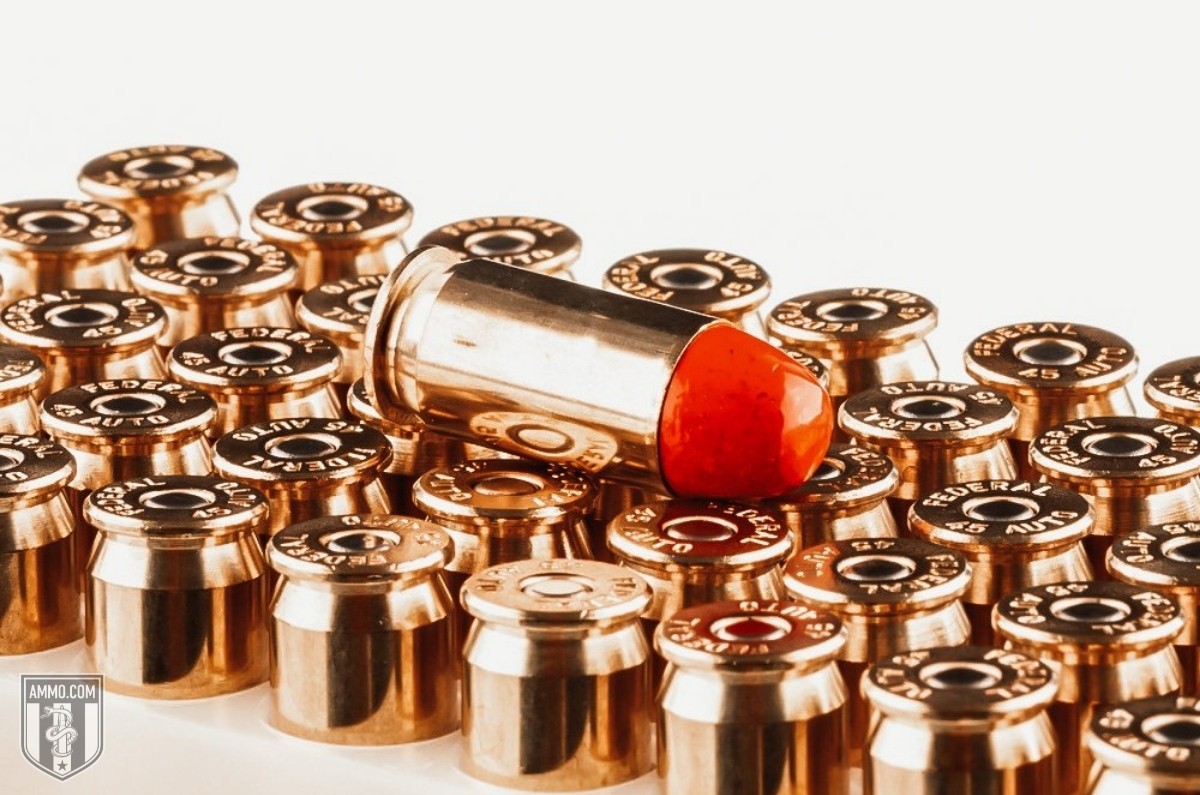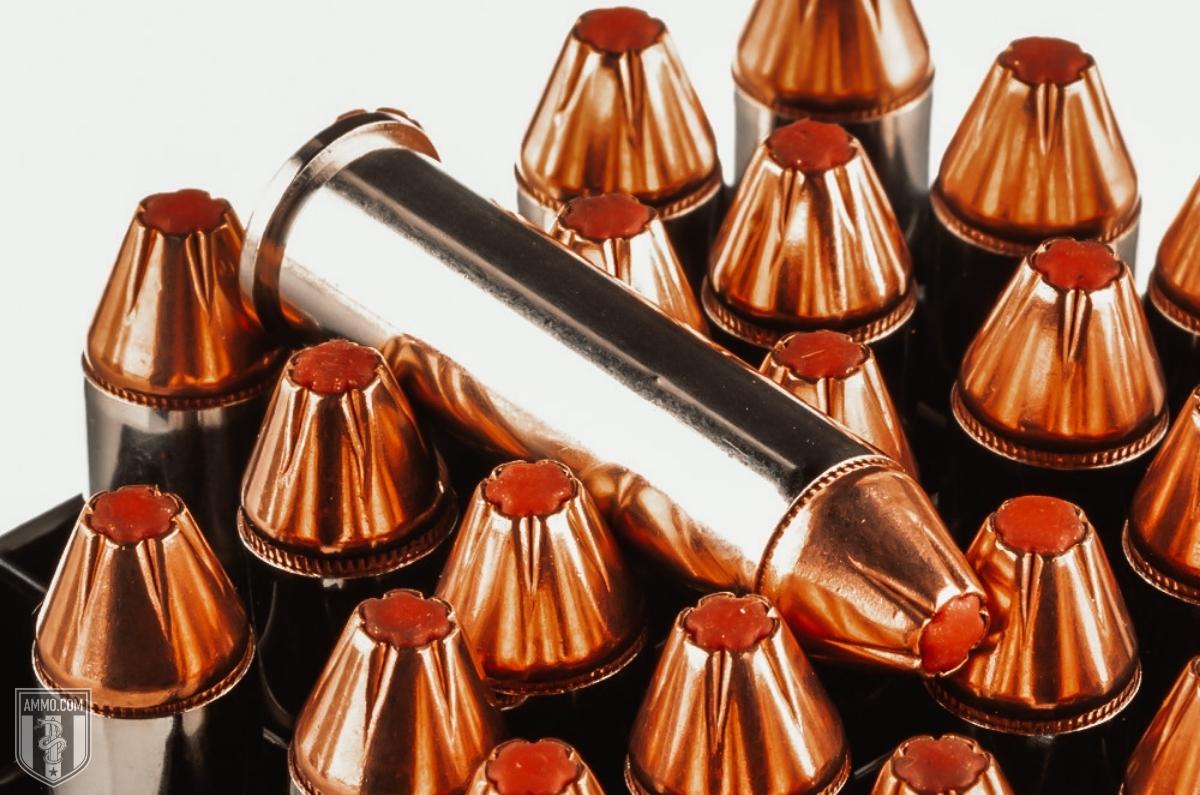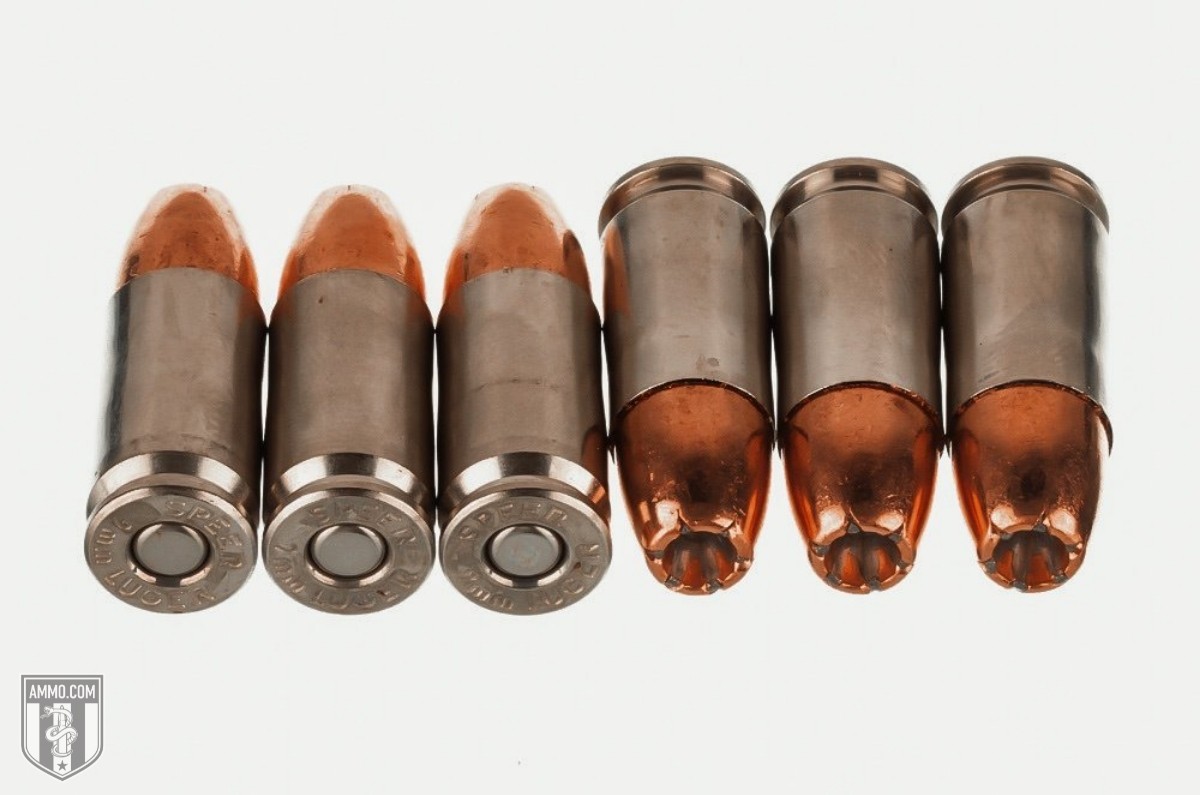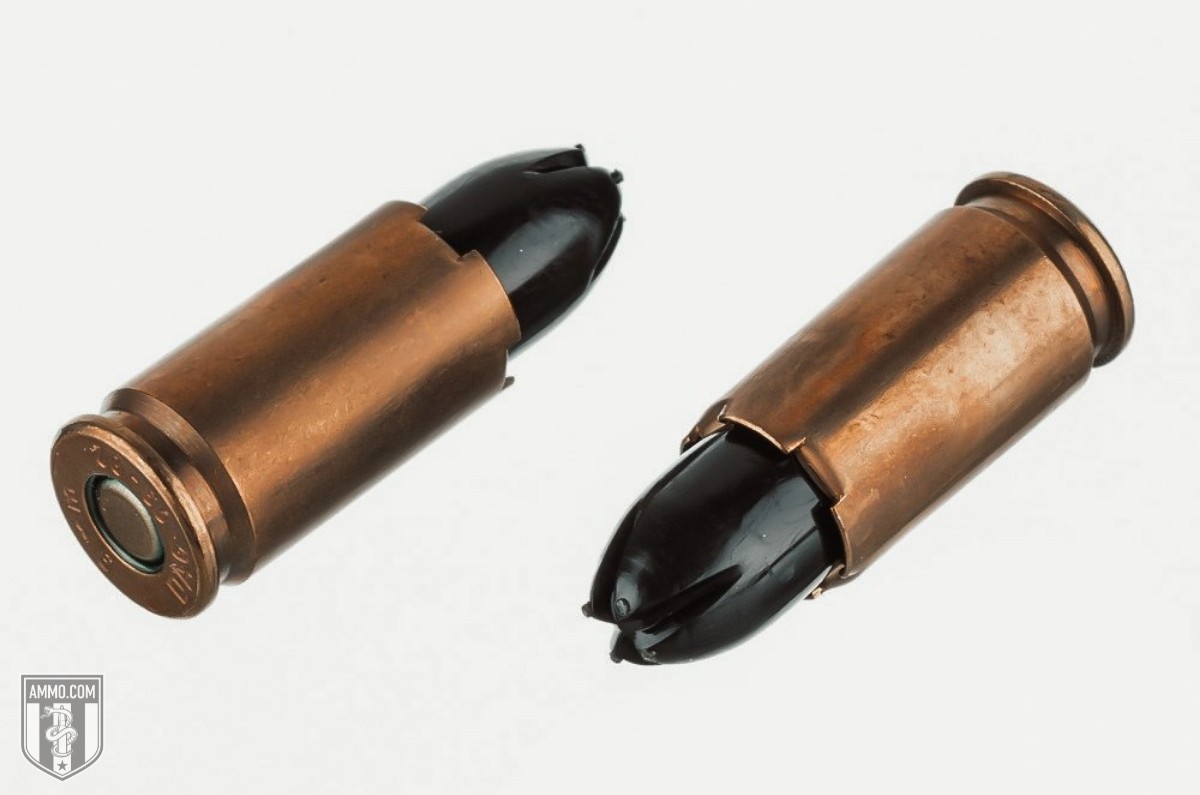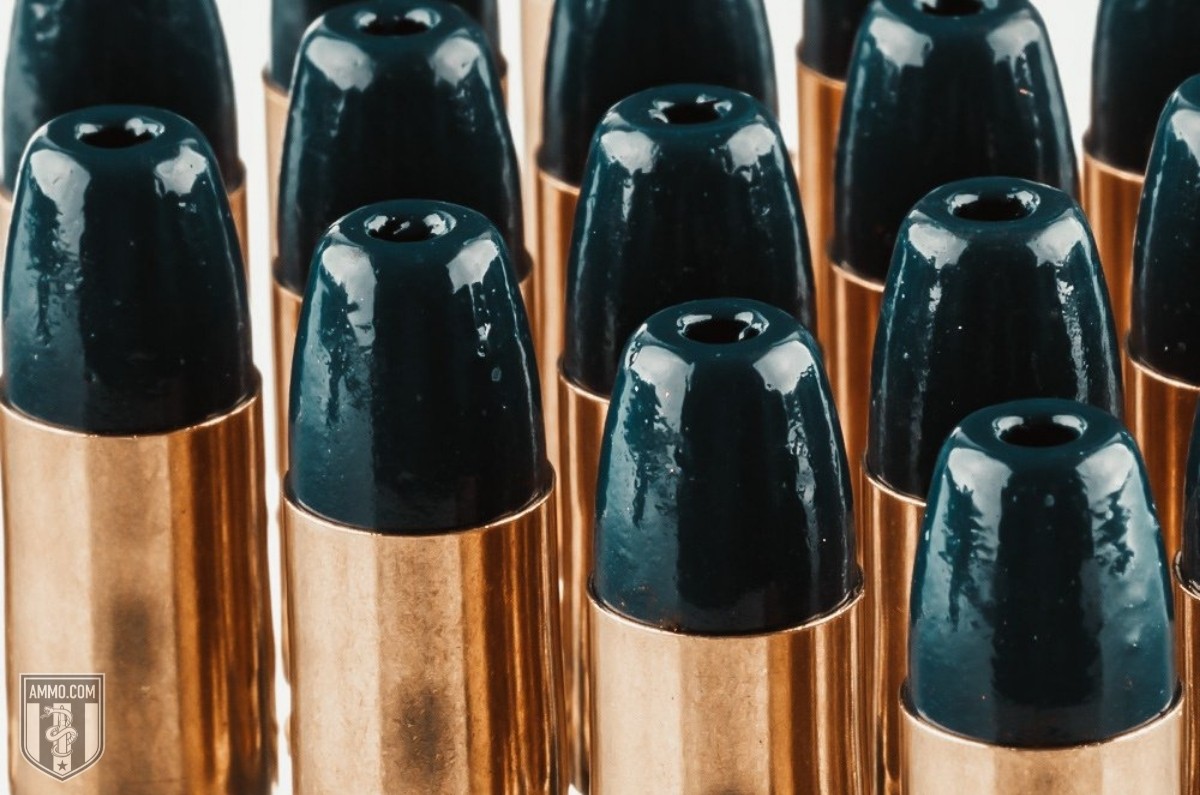357 Magnum vs 9mm: Revolver or Semi-Auto for Self-Defense?
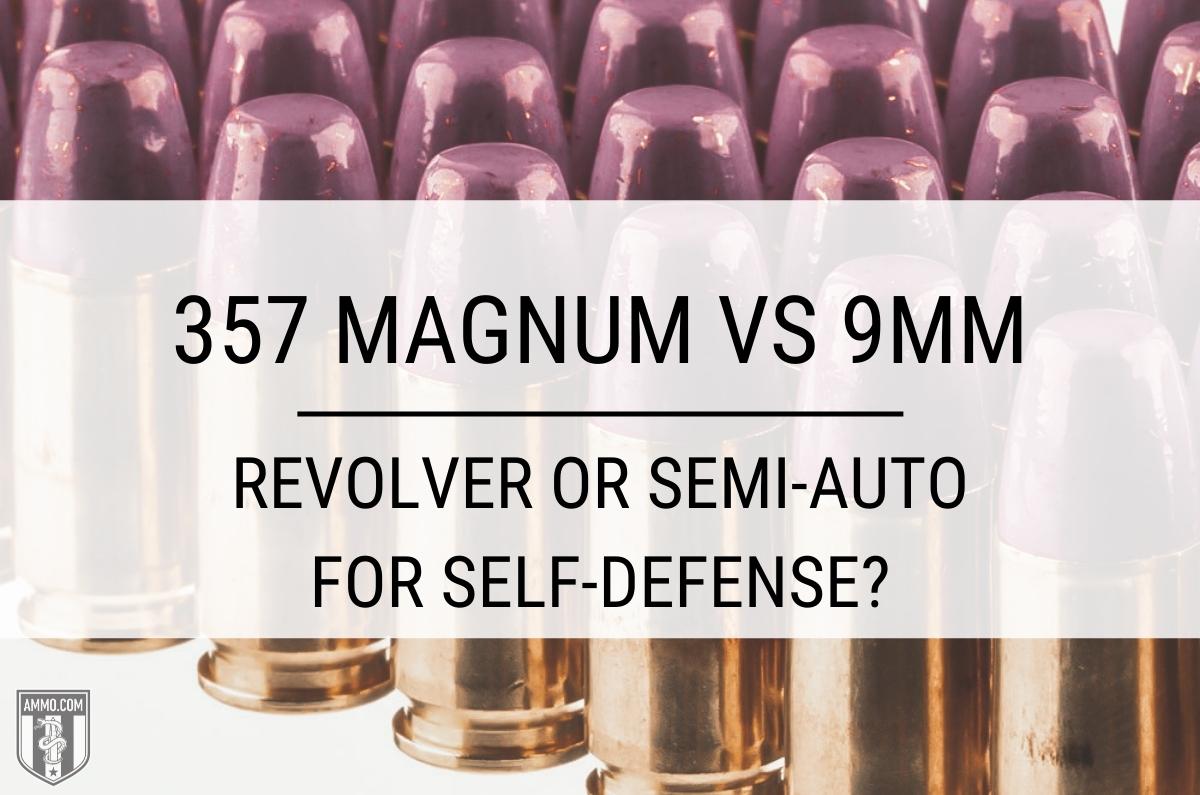 When discussion handgun calibers, it is inevitable that the 9mm vs 357 Magnum debate comes into the discussion.
When discussion handgun calibers, it is inevitable that the 9mm vs 357 Magnum debate comes into the discussion.
Although the decision between the 9mm Luger and 357 Magnum really boils down to whether you prefer a revolver or semi-automatic handgun, there are specific benefits to each cartridge that could sway a shooter one direction or the other.
In this article we will take an in-depth look at the 9mm and 357 Magnum handgun cartridges and help you understand which one is better for your needs.
What is The Difference Between .357 Magnum and 9mm?
The primary difference between 357 Magnum vs 9mm is that the 357 Mag is a revolver cartridge and the 9mm Luger was designed for semi-auto pistols. The 357 Magnum is a rimmed handgun cartridge that will have higher velocity, muzzle energy, and recoil while the 9mm Luger is a rimless design that has lower recoil and higher magazine capacity.
Cartridge Specs
When comparing two handgun cartridges, it’s a good practice to examine the differences in case design to gain more knowledge of each.
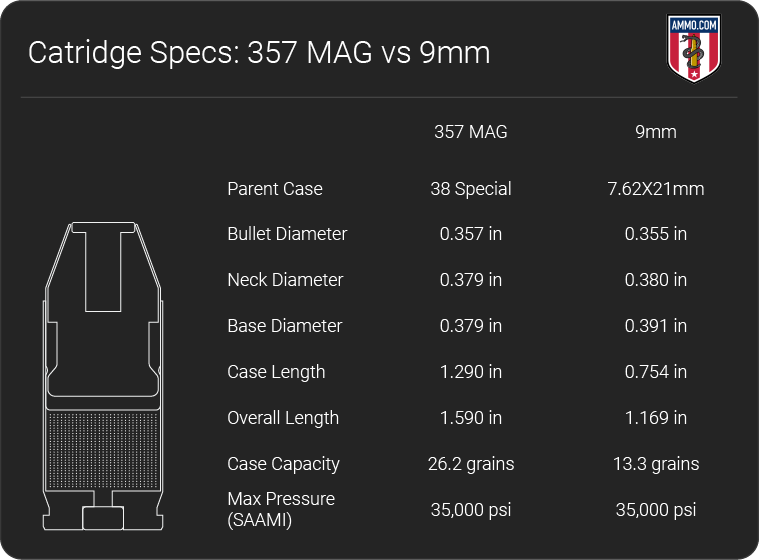
One striking similarity that some shooters might not be aware of is that the 9mm and 357 have almost the same bullet diameter. Notice that I said “almost”, as they are separated by 0.002”. The 357 Magnum fires a 0.357” diameter bullet while the 9mm fires a 0.355” diameter bullet.
Although the bullets are almost the same diameter, the case length and case capacity are strikingly different. The 9mm Luger has a case length of 0.754” and case capacity of 13.3 gr.
However, the 357 Magnum towers over it with a case length of 1.290” and 26.2 gr case capacity. This means that the 357 is over a half inch longer with almost double the case capacity, which will have a profound affect on the ballistics for both cartridges.
One benefit of the added cases capacity of the 357 Mag is that it can fire heavier bullets than the 9mm. Normal factory loads for 9mm are either 115 gr, 124 gr, or 147 gr. While 357 can be loaded with bullets weights as high as 180 grains.
With all that added case capacity, it would make sense that the 357 Magnum would be a higher-pressure round, but that is not the case. Both the 9mm and 357 have the same maximum pressure of 35,000 psi as defined by SAAMI.
Stopping Power/Kinetic Energy
Stopping power is one of those ubiquitous terms that gets thrown around campfires and gun store counters and is completely unquantifiable. You’ll hear stories of how boutique rounds like the 357 SIG have “More stopping power than a 380 Auto” or how, “The 45 ACP is a real man stopper.”
The important thing to remember is that shot placement is more important than any ballistics values as a .22LR between the eyes will always be more lethal than a 500 Smith & Wesson Magnum to the hand.
However, we can quantify how many ft-lbs of force is imparted upon the target for each cartridge.
Muzzle energy is directly correlated to bullet weight and muzzle velocity, and different factory loads will have different foot-pounds of energy based on how hot they want to make the cartridge.
If there’s one thing that 357 Magnum loads are known for, it’s power. It got the “magnum” designation for a reason as the 357 has exception muzzle energy for a revolver round.
Looking at the ballistics tables below, we see that the 357 Magnum has higher muzzle energy for most of the handgun rounds listed.
On average, the 357 has about 600 ft-lbs of energy at the muzzle compared to an average of 340 ft-lbs for 9mm.
But all that muzzle energy comes at the cost of recoil.
Recoil
Recoil is an important consideration when purchasing a new self-defense handgun. A round with heavy recoil will be more difficult to control and will slow your rate of follow up shots.
Recoil is affected primarily by muzzle velocity (FPS) and bullet weight. The faster a bullet travels, the harder it pushes back on the shooter. Furthermore, a heavier bullet requires more force to push it out the barrel, which is returned to the shooter’s wrists.
When comparing 9mm vs 357, the 9mm is well known for being soft-shooting and having lower recoil. This makes it extremely popular in the military, law enforcement, and for civilian concealed carry as it allows for faster follow-up shots.
By comparison, the 357 Magnum is known for having stout recoil as all that added case capacity comes at a price.
On average, the 357 Mag shooter should feel around 10 ft-lbs of recoil compared to 4.5 foot-pounds for 9mm.
The 9mm Luger is the clear winner in terms of recoil.
Velocity/Penetration
Muzzle velocity is very important when it comes to self-defense rounds, as higher velocity typically correlates to deeper penetration into the target. Penetration is important as a bullet must reach and effectively damage the vital organs to incapacitate an attacker.
Muzzle velocity is dependent upon several factors that include but are not limited to barrel length, bullet weight, and powder charge.
Barrel length is something that some shooters might not consider when looking at muzzle velocity, as handgun round fired from a 2 inch barrel will have a lower muzzle velocity than the same round fired from a 4 inch barrel.
Looking at the ballistics tables below, we can see that the 357 Magnum loads generally has higher muzzle velocity than comparable 9mm ammo.
Take for example the 125 grain jacketed hollow point for 357 and the 124 grain bullet for 9mm. Both have similar weight but the 357 has a muzzle velocity of 1,450 fps compared to 1,150 fps for the 9mm round. Even Federal Premium HST personal defense 124 grain +P 9mm at 1,200 fps cannot hold a candle to the 357.
It’s clear that the revolver cartridge is superior in terms of velocity, but how about penetration?
The FBI standardized personal defense ammo penetration testing after the 1986 Miami Shootout, stating that a jacketed hollow point (JHP) round should penetrate no less than 12” but no more than 18” into a 10% ballistic gel block.
The terminal performance of 1980’s era 9mm Luger self-defense ammo was not spectacular. However, hollow point bullet design has advanced considerably over the years and has brought the 9mm Parabellum back into favor for law enforcement and the FBI.
Both the 357 and 9mm meet the FBI’s minimum penetration requirements. However, as the 357 Mag was designed for higher velocity, it will generally have deeper penetration than the 9mm Luger.
Deeper penetration can be a liability as much as an asset, as over penetration is a real issue with 357 Magnum. Therefore, it is critical to evaluate your chosen self-defense ammo for your 357 Magnum revolver. Winchester PDX1, Speer Gold Dot, and Remington Golden Saber JHP ammo are all excellent choices you can pick up here at Ammo.com.
Magazine Capacity
A 357 Magnum revolver simply cannot compete with the magazine capacity of semi-auto pistols.
A full-size Glock 17 can hold 17 rounds of 9mm Luger while a similarly sized Smith & Wesson Model 686 can carry 6 rounds of 357.
However, if you prefer to concealed carry something smaller and lighter, a Glock 26 magazine carried 10 rounds compared to a snub nose revolver like the Ruger LCR that only carries 5 rounds of 357.
The bottom line is that a revolver simply cannot compare to the magazine capacity of 9mm pistols.
Hunting
In terms of hunting, the 357 Magnum is clearly the better option as some factory hunting loads have the muzzle energy to handle medium sized game. A lever-action carbine chambered in 357 Mag is a formidable close range deer gun with proper hunting ammo.
Also, since the 357 has higher muzzle velocity, it will have a flatter trajectory compared to the 9mm. This makes longer range shots easier with the 357.
The 9mm Luger is a great choice for self-defense, but for hunting it lacks enough foot-pounds of muzzle energy to take down a whitetail. The Ruger PC Carbine would make a reasonable varmint rifle, however the 9mm’s trajectory leaves something to be desired for a varmint round.
The 9mm just doesn’t have the terminal ballistics or trajectory to make it a good hunting round, and is a good example of a handgun cartridge that is great for personal defense but inadequate for hunting.
On the other hand, the 357 is an excellent hunting round as it has the stopping power, trajectory, and range necessary to hunt deer-sized animals or feral hogs.
Just remember to stock up before hunting. Check out our Fiocchi 357 ammo for more affordable ammo option.
Concealed Carry/Home Defense
The 357 Magnum and 9mm Parabellum are both excellent self-defense handgun cartridges.
However, when it comes to concealed carry, the 9mm round is likely the better choice due to its low recoil and high magazine capacity.
Many concealed carry permit holders prefer to carry sub-compact pistols or snub nose revolvers as they are lighter and easier to conceal. That’s all well and good, until you have to pull the trigger.
The truth is that a 357 Magnum in a light-weight revolver is going to be difficult to control and can be downright painful to shoot without proper grip and training. Felt recoil is directly related to handgun weight, therefore the lighter the handgun, the higher the recoil. This leads many shooters to carry 38 Special or 38 Special +P instead of 357 Mag as it is easier to control and pleasant to shoot.
The argument could then be made that you should concealed carry a full-size revolver as the extra weight would reduce recoil and increase your capacity by 1 round. This is definitely an option that some shooters opt for, however most CCW permit holders find it awkward to conceal a full-size revolver due to the weight and barrel length.
One final mark against the 357 is that speed loaders for revolvers are bulky and require specific wardrobe considerations from proper concealment. And unless you’re Jerry Miculek, most shooters can reload a semi-auto pistol considerably faster than a revolver.
A 9mm pistol will generally be easier to conceal as they can be thinner than a revolver, will have less recoil for faster follow-up shots, 9mm ammo is lighter than 357 so you can carry more bullets, and semi-auto pistols are faster to reload. All these qualities are excellent for concealed carry.
For home defense, the 357 Magnum round makes an excellent choice for its superior muzzle energy and stopping power. Inside the home, handgun weight is less of a hinderance as pulling your 357 Magnum revolver out of the gun safe is a lot easier than carrying it on your hip all day.
For stopping a threat in the home, the terminal ballistics of the 357 Mag really shine, making it the better choice.
This does not mean that the 9mm is ineffective for home defense. On the contrary, it is a fine choice and will not let you down in any self-defense situation. However, in this situation, the 357 Magnum is just a little bit better.
One last thing to remember is that you should always use high quality jacketed hollow point (JHP) ammo for your home defense or concealed carry handgun to prevent over penetration. The last thing you want is for a bullet you fire to hit an innocent bystander or damage private property as you will be liable for this.
Just make sure you get all your self-defense JHP ammo here at Ammo.com and you should be fine!
Ammo and Handgun Cost/Availability
When it comes to cost and availability for both handguns and ammo, it’s hard to beat the 9mm Luger.
At the time of writing, FMJ practice ammo for 9mm will run you around $0.40/round while JHP self-defense ammo like Speer Gold Dot or Hornady Critical Defense ammo will cost about $1/round.
Speaking of ammo price make sure to check out our stock of Hornady 357 Magnum ammo for more options.
Buying in bulk is always smart, make sure to check out our stock of 9mm bulk ammo.
By comparison, practice FMJ 357 ammo will cost around $1/round and $2/round for JHP ammo.
This cost trend continues when it comes to handguns due to the overwhelming popularity of the 9mm Luger.
Virtually every handgun manufacturer offers semi-auto pistols chambered in 9mm. Furthermore, the cost of manufacturing these handguns is lower as many of them use polymer frames like the Glock 19, Springfield XD, and Smith & Wesson M&P.
Revolvers, however, require considerably more precision and engineering to produce. Most revolver frames are made from steel, not polymer, and this increase the overall materials cost for a 357 Magnum revolver.
Most high quality 357 revolvers from Smith & Wesson or Ruger will be about double the cost of a polymer-framed 9mm pistol.
As the 9mm is one of the most popular handgun cartridges for military, law enforcement, and civilian shooters, it’s not surprising that it has a lower overall cost compared to the 357.
Reloading
When it comes to reloading, the 357 Magnum and the 9mm are excellent options for beginners to start with.
As they are both straight walled handgun cartridges, the use of case lube is not requires provided you purchase carbide dies.
This makes it very easy to handload both cartridges. Furthermore, there is a wide variety of components to select from to make your ideal handgun cartridge. Manufactures like Hornady, Sierra, Nosler, Speer, and Federal all make a wide variety of bullets for you to select from.
The 357 offers even more customization possibilities due to its large case capacity. You can load them light for practice or hotter to simulate the recoil of self-defense ammo.
Both handgun cartridges are a joy to reload and help reduce the overall cost per round to shoot your favorite revolver or pistol.
.357 vs 9mm Ballistics
Our team here at Ammo.com has spent countless hours scouring the Internet to bring you extremely comprehensive ballistics tables for both calibers. These tables will compare bullet weight to muzzle velocity, kinetic energy, and trajectory.
357 Magnum Ballistics: Chart of Average 357 Magnum Ballistics
Note: This information comes from the manufacturer and is for informational purposes only. The actual ballistics obtained with your firearm can vary considerably from the advertised ballistics. Also, ballistics can vary from lot to lot with the same brand and type load.
| 357 Magnum Bullet WEIGHT | Muzzle VELOCITY (fps) | Muzzle ENERGY (ft. lbs.) | Mid-Range TRAJECTORY (in.) | Barrel Length (in.) | |||||
|---|---|---|---|---|---|---|---|---|---|
| Muzzle | 50 yds. | 100 yds. | Muzzle | 50 yds. | 100 yds. | 50 yds. | 100 yds. | ||
| 105 Grain | 1650 | n/a | n/a | n/a | 385 | n/a | n/a | n/a | n/a |
| 110 Grain | 1295 |
1095 | 975 | 410 | 290 | 230 | 0.8 | 3.5 | 4-V |
| 125 Grain Medium Velocity | 1220 | 1075 | 985 | 415 | 315 | 270 | 0.8 | 3.7 | 4-V |
| 125 Grain JHP | 1409 | n/a | n/a | 551 | n/a | n/a | n/a | n/a | n/a |
| 125 Grain | 1450 | 1240 | 1090 | 585 | 425 | 330 | 0.6 | 2.8 | 4-V |
| 125 Grain | 1500 | 1312 | 1163 | 624 | 478 | 376 | n/a | n/a | 8" |
| 125 Grain JHP | 1600 | n/a | n/a | 771 | n/a | n/a | n/a | n/a | n/a |
| 140 Grain Multi-Ball | 1155 | 830 | 665 | 420 | 215 | 135 | 1.2 | 6.4 | 4-V |
| 140 Grain | 1360 | 1195 | 1075 | 575 | 445 | 360 | 0.7 | 3 | 4-V |
| 140 Grain FlexTip | 1440 | 1274 | 1143 | 644 | 504 | 406 | n/a | n/a | n/a |
| 145 Grain | 1290 | 1155 | 1060 | 535 | 430 | 360 | 0.8 | 3.5 | 4-V |
| 150 Grain | 1235 | 1105 | 1015 | 535 | 430 | 360 | 0.8 | 3.5 | 4-V |
| 158 Grain | 1235 | 1105 | 1015 | 535 | 430 | 360 | 0.8 | 3.5 | 4-V |
| 158 Grain Cowboy | 800 | 761 | 725 | 225 | 203 | 185 | n/a | n/a | n/a |
| 158 Grain JHP | 1350 | n/a | n/a | 640 | n/a | n/a | n/a | n/a | n/a |
| 158 Grain Remington Maximum | 1825 | 1590 | 1380 | 1170 | 885 | 670 | 0.4 | 1.7 | 10.5" |
| 165 Grain | 1290 | 1189 | 1108 | 610 | 518 | 450 | 0.7 | 3.1 | 8-3/8" |
| 180 Grain | 1145 | 1055 | 985 | 525 | 445 | 390 | 0.9 | 3.9 | 4-V |
| 180 Grain | 1180 | 1088 | 1020 | 557 | 473 | 416 | 0.8 | 3.6 | 8-V |
| 180 Grain CorBon F.A. | 1650 | 1512 | 1386 | 1088 | 913 | 767 | 1.66 | 0 | n/a |
| 200 Grain | 1200 | 1123 | 1061 | 640 | 560 | 500 | 3.19 | 0 | n/a |
9mm Ballistics: Chart of Average 9mm Luger Ballistics
Note: This information comes from the manufacturer and is for informational purposes only. The actual ballistics obtained with your firearm can vary considerably from the advertised ballistics. Also, ballistics can vary from lot to lot with the same brand and type load.
| 9mm Bullet WEIGHT | Muzzle VELOCITY (fps) | Muzzle ENERGY (ft. lbs.) | Mid-Range TRAJECTORY (in.) | Barrel Length (in.) | |||||
|---|---|---|---|---|---|---|---|---|---|
| Muzzle | 50 yds. | 100 yds. | Muzzle | 50 yds. | 100 yds. | 50 yds. | 100 yds. | ||
| 80 Grain | 1445 | n/a | n/a | n/a | 385 | n/a | n/a | n/a | n/a |
| 88 Grain | 1500 |
1190 | 1010 | 440 | 275 | 200 | 0.6 | 3.1 | 4" |
| 90 Grain | 1360 | 1112 | 978 | 370 | 247 | 191 | n/a | n/a | 4" |
| 92 Grain | 1325 | 1117 | 991 | 359 | 255 | 201 | -3.2 | n/a | 4" |
| 95 Grain | 1300 | 1140 | 1010 | 350 | 275 | 215 | 0.8 | 3.4 | 4" |
| 100 Grain | 1180 | 1080 | n/a | 305 | 255 | n/a | 0.9 | n/a | 4" |
| 105 Grain "Guard Dog" | 1230 | 1070 | 970 | 355 | 265 | 220 | n/a | n/a | 4" |
| 115 Grain | 1155 | 1045 | 970 | 340 | 280 | 240 | 0.9 | 3.9 | 4" |
| 123 Grain | 1110 | 1030 | 970 | 340 | 290 | 260 | 1 | 4 | 4" |
| 124 Grain | 1150 | 1040 | 965 | 364 | 298 | 256 | -4.5 | n/a | 4" |
| 125 Grain | 1110 | 1030 | 970 | 340 | 290 | 260 | 1 | 4 | 4" |
| 135 Grain | 1010 | 960 | 918 | 306 | 276 | 253 | n/a | n/a | 4" |
| 140 Grain | 935 | 890 | 850 | 270 | 245 | 225 | 1.3 | 5.5 | 4" |
| 147 Grain | 990 | 940 | 900 | 320 | 290 | 265 | 1.1 | 4.9 | 4" |
| 90 Grain +P | 1475 | n/a | n/a | 437 | n/a | n/a | n/a | n/a | 4" |
| 115 Grain +P | 1250 | 1113 | 1019 | 399 | 316 | 265 | 0.8 | 3.5 | 4" |
| 124 Grain +P | 1180 | 1089 | 1021 | 384 | 327 | 287 | 0.8 | 3.8 | 4" |
.357 Magnum Development and History
Regarded as the Father of the Modern Magnum, Elmer Keith is credited with the development of the 357 Magnum, and later the 44 Magnum and the 41 Magnum.
Keith, in conjunction with Phillip Sharpe, worked on increasing the power of the 38 Special by dosing it with a bit more powder. To accommodate the increased powder charge, the 38 Special case was elongated by about 0.15”, preventing a 357 Magnum round from chambering in a 38 Special revolver.
Elmer Keith designed the round to fire a 0.357” diameter bullet at 1450 FPS out of a 4 inch barrel. The resulting cartridge was submitted to Smith & Wesson in 1934, and thus the 357 Magnum was born.
The new cartridge was primarily marketed to law enforcement who needed a more powerful handgun round to combat bootleggers and the mafia. Criminals of the Prohibition Era were wearing early ballistic vests and using cars for cover, and although the 38 Special was ineffective against these defenses, the 357 Magnum was more than up to the task.
Since its adoption, the 125 grain JHP 357 Magnum round has been considered the gold standard for personal defense cartridges. It is so effective that many ammo manufacturers have tried to replicate the terminal ballistics of the cartridge, the 357 SIG being the most notable of the bunch.
Regardless of your feelings towards revolvers, the 357 Magnum is a cartridge that should not be underestimated in its defensive capabilities.
If you’d like to learn more about how the 357 Magnum compares to other calibers, check out 38 Special vs 357 and 10mm vs 357 Mag!
9mm Development and History
The 9x19mm Luger was designed by the Austrian gunsmith Georg Luger in 1901. Luger derived the 9mm Parabellum from his previous design, the 7.65x21mm Parabellum.
In 1903 he presented the 9mm Luger to the US military for consideration at the Springfield Arsenal and was in competition with John Moses Browning and the 45 ACP. The 9mm was not adopted by the US military until much later and was instead picked up by the German Imperial Navy and Army in 1904 and 1908, respectively.
The 9x19mm Luger is also referred to as the 9x19mm, 9mm Parabellum, or simply the 9mm. SAAMI specs list the maximum pressure for 9mm at 35,000 psi and standard 115 grain FMJ ammo will have an average muzzle velocity of 1180 fps and a muzzle energy of 355 foot-pounds.
After World War I and through World War II, 9mm ammo became one of the most popular handgun cartridges in Europe for both military and law enforcement. However, the United States was late to the party as it clung to the idiom, “Bigger Bullets are Better” and our beloved 45 ACP until the 1980’s with the adoption of the Beretta M9 Service Pistol by the US Army.
The popularity of the 9mm Luger really exploded in the United States during the 80’s and 90’s with the introduction of extremely reliable semi-auto pistols, such as the Glock 17, the Sig Sauer P226, and more recently the Springfield XD and the Smith & Wesson M&P.
Fervor for the 9mm round has only been bolstered by the U.S. military’s adoption of the Sig Sauer P320 as the new standard issue sidearm for military personnel.
The 9mm has become synonymous with law enforcement and home defense for its high magazine capacity, stopping power using jacketed hollow point ammo (JHP), and low overall cost per round.
9mm pistols are extremely easy to come by and are relatively inexpensive as all major firearms manufactures carry some offering for the 9mm cartridge: Glock, Smith & Wesson, Sig Sauer, Kimber, Springfield, Remington, Ruger, and Taurus, just to name a few!
It has truly become the everyday carry (EDC) handgun of choice if you don’t want to carry something more chunky and snappier like a 357 Magnum. And with advancements in hollow point technology, the 9mm has solidified itself as the self-defense ammo of choice for the military, law enforcement, and the civilian concealed carry permit holder.
If you’d like to learn more about how the 9mm compares to other calibers, check out the articles below:
- .380 ACP vs 9mm
- 9mm vs 45 ACP
- 9mm vs 40 S&W
- 357 SIG vs 9mm
- 10mm vs 9mm
- 9mm vs 9mm Luger
- 9mm vs 40 vs 45
Final Shots: 357 Magnum vs 9mm
The 357 Magnum and 9mm Luger are two handgun cartridges that offer different ballistic benefits.
The 9mm Luger has low recoil making follow-up shots easier. Many shooters report they are more accurate with a 9mm as there is a lower tendency to flinch during the firing process. Its massive magazine capacity makes it a great option for concealed carry and self-defense.
The 357 Magnum is sheer stopping power in a revolver cartridge. Its muzzle energy and higher velocity is well known, and it can shoot heavier bullets than the 9mm. However, all that added power comes at the cost of heavy recoil that some shooters cannot handle except with a full-sized revolver.
However, all of the ballistic data and cartridge specs don’t matter until you answer one simple question:
Semi-automatic pistol or revolver?
Once you answer that question, then the choice of handgun calibers becomes elementary.
Pick which handgun style you prefer and load up on FMJ’s and JHP’s here at Ammo.com so that you can perfect your marksmanship skills and be ready for any self-defense situation.
Ammo Comparisons
- .308 vs 5.56
- 6.5 Creedmoor vs .308
- .300 Blackout vs .308
- .300 Win Mag vs .308
- .243 vs .308
- .308 vs .30-06
- 7mm-08 vs .308
- .270 vs .308
- 7.62x39 vs .308
- .223 vs .308
- .338 Lapua vs .308
- .380 ACP vs 9mm
- .223 vs 5.56
- .300 Blackout vs 5.56
- 9mm vs 45 ACP
- 9mm vs 40 S&W
- .357 SIG vs 9mm
- 10mm vs 9mm
- 9mm vs 9mm Luger
- .243 vs .270
- .300 Win Mag vs .30-06
- .270 vs .30-06
- .40 vs .45
- 38 Special vs 357
- 9mm vs 40 vs 45
- 5.56 vs 7.62x39
- 338 Lapua vs .30-06
- .30-30 vs .30-06
- 300 PRC vs 338 Lapua
- .30-06 vs 7mm
- 300 Win Mag vs 338 Lapua
- 300 PRC vs 300 Win Mag
- 300 WSM vs 300 Win Mag
- 338 Win Mag vs 338 Lapua
- 12 Gauge vs 20 Gauge
- 10mm vs 357 Mag
- .30-30 vs 7.62x39
- 224 Valkyrie vs 22-250
- 17 HMR vs 22 Mag
- 7.62x39 vs .300 Blackout
- 45 ACP vs 45 Auto
- 45-70 vs 30-30
- 300 Blackout vs 223
- 357 Magnum vs 9mm
- 350 Legend vs 300 Blackout
- 224 Valkyrie vs 223
- 45 ACP vs 38 Super
- 6.5 Grendel vs .308
- 17 HMR vs 22 LR
- 10 Gauge vs 12 Gauge
- 22-250 vs 223
- 45 Colt vs 45 ACP
- 350 Legend vs 30-30
- 5.7x28 vs 223
- 5.7 vs 9mm
- 5.56 vs 5.7
- 22 vs 9mm
- Buckshot vs Birdshot
- 450 Bushmaster vs 308
- 450 Bushmaster vs 223
- Buckshot vs Slug
- 6.5 Grendel vs 5.56 vs 223
- 6mm ARC vs 6.5 Grendel
- 44 vs 45
- 458 SOCOM vs 5.56
- 357 vs 44
- 32 ACP vs 380
- 300 Win Mag vs 338 Win Mag vs 338 Lapua Mag
- 450 Bushmaster vs 458 SOCOM vs 50 Beowulf
- 6mm Creedmoor vs 6.5 Creedmoor
- TMJ vs FMJ
- 44 Special Vs 44 Magnum
- 45 90 vs 45 70
- 6.8 Western vs 6.8 SPC
- 50 Beowulf vs 50 BMG
- 26 Nosler vs 6.5 PRC
- 28 Gauge vs 410
- 6.8 SPC vs 5.56
- 6.8 SPC vs 6.5 Grendel
- 6.8 Western vs 7mm Rem Mag vs .28 Nosler
- 6.8 Western vs 6.5 Creedmoor
- 22 Hornet vs 223
- 6.8 Western vs 6.5 PRC
- .410 vs 12 Gauge
- .410 vs 20 Gauge
- 22 LR vs 22 Mag
- 6mm ARC vs 243
- 7mm-08 vs 270
- 243 vs 6.5 Creedmoor
- Nickel vs Brass Casing
- 204 Ruger vs 223
- 50 Beowulf vs 5.56
- 260 Remington vs 6.5 Creedmoor
- 6mm Remington vs 243
- 28 Nosler vs 300 PRC
- 50 Beowulf vs 50 AE
- 22 Nosler vs 22-250
- 450 Marlin vs 45-70
- 300 Win Mag vs 300 Norma
- 458 SOCOM vs 300 Blackout
- 38-55 vs 45-70
- 22 Hornet vs 22 LR
- 300 Norma vs 338 Lapua
- 338 Lapua vs 50 BMG
- 28 Nosler vs 300 Win Mag
- 28 Nosler vs 6.5 Creedmoor
- 204 vs 22-250
- 458 SOCOM vs 45 70
- 44 40 vs 45 70
- 6.8 SPC vs 6.5 Creedmoor
- 450 Bushmaster vs 30-06
- 7mm Rem Mag vs 300 Win Mag
- 30 Carbine vs 223
- 25-06 vs 30-06
- 26 Nosler vs 28 Nosler
- 16ga vs 12ga
- 30 06 vs 7.62 x54R
- 9mm Makarov vs 9mm Luger
- 350 Legend vs 223
- 30 Carbine vs 5.56
- 6.5x55 vs 6.5 Creedmoor
- 6.5 Creedmoor vs 270 vs 25-06
- M193 vs M855
- 450 Bushmaster vs 458 SOCOM
- 6.5 Grendel vs 6.5 Creedmoor
- 350 Legend vs 5.56
- .277 Fury vs 6.8 SPC
- 277 Fury vs 300 Win Mag
- 10mm vs .45 ACP
- 277 Fury vs 223
- 6.8 SPC vs 300 Blackout
- 6.5 PRC vs 6.5 Creedmoor
- 277 Fury vs 308
- 277 Fury vs 6.5 Creedmoor
- 350 Legend vs 450 Bushmaster
- 277 Fury Vs 5.56 NATO
- 10mm vs 40S&W
- 32 ACP vs 9mm
- 32 Special vs 9mm
- 8.6 Blackout vs 300 Blackout
- 30 Super Carry vs. 9mm
- 5.56 vs 9mm
- .50 Action Express vs 9mm
- 7.62x25 vs. 9mm
- 10mm vs 44 Magnum
- 300 Blackout vs 300 Win Mag
- 6.5 Grendel vs 300 Blackout
- 460 Rowland vs 10mm
- 300 RUM vs 300 PRC
- 300 Norma vs 300 PRC
- 45 GAP vs 45 ACP
- 7mm PRC vs 300 Win Mag
- 300 PRC vs 6.5 Creedmoor
- 300 PRC vs 308
- 357 SIG vs 357 Mag
- 7.62x39 vs 7.62x51
- 243 Win vs 223 Rem
- 30 Nosler vs 300 PRC
- 6.5 Creedmoor vs. 30-06 Springfield
- 450 S&W vs. 44 Magnum
- 6.5 Creedmoor vs. 300 Win Mag
- 454 Cassull vs. 45-70 Govt
- 454 Cassull vs. 44 Mag
- 7.62x54r vs. 308 Winchester
- 22 ARC vs. 223 Rem
